 Research Article
Research Article
Efficacy and Selectivity of Herbicides Flumioxazin (Pledge 50 WP) and Pendimethalin (Pendistar 40 SK) in Lavender
Miroslav Tityanov1*, Anyo Mitkov1, Mariyan Yanev1, Nesho Neshev1, Tonyo Tonev1, Zarya Rankova2, Cveta Moskova3 and Evgenia Velinova4
1Agricultural University of Plovdiv, 12 Mendeleev Blvd Plovdiv, Bulgaria
2Fruit Growing Institute – Plovdiv, 12 Ostromila Str Plovdiv, Bulgaria
3Forestry University –Sofia, 10 Kliment Ohridski Blvd Sofia, Bulgaria
4Summit Agro, 39 Bigla str Sofia 1164, Bulgaria
Miroslav Tityanov, Agricultural University of Plovdiv, 12 Mendeleev Blvd., Plovdiv, Bulgaria.
Received Date:November 14, 2022; Published Date:December 12, 2022
Introduction
In recent times, a deep interest has been addressed worldwide to the search for a “new” crop, to be allocated to farming systems in which traditional crops are losing competitiveness, and also meant as a diversification option for farmers who want to increase their income [4]. To be successful, a “new” crop must meet a number of conditions: it must be economically reliable; it must be grown using the minimum amount of off-farm technical inputs as possible; and it should find a place in an “integrated” scheme of weed control. Lavender is one of the key essential oil crops under the conditions of Bulgaria [5]. Weeds are among the main factors determining to a great extend the yield in terms of quantity and quality. The weed control in lavender should be carried out systematically. The most common weeds in the different regions of the country are several. The main grass weeds found in lavender fields are Echinochloa crus-galli, Setaria spp. and Cynodon dactylon. The main broad leave weeds which are infesting lavander are Amaranthus retroflexus, Chenopodium album, Senecio vulgaris, Sinapis arvensis, Polygonum aviculare, Galinsoga parviflora, Cirsium arvense, Convolvulus arvensis etc.
The chemical weed control creates favorable conditions for full mechanization of agricultural crops, allowing to increase the effi ciency of the agrotechnical measures and parameters for the crop [6]. The weed species that invade the crop can be destroyed not only by manual and mechanical hoeing but also by chemically and using herbicides, too. Herbicides are important due to their opportunities that offer destroying the damages provoked by weeds and getting high yields, too. Different herbicides can be used as Devrinol 4 F – rate 3 kg/Ha, Fusilate Forte – 2 L/Ha, Targa Super – 1,5 L/Ha. To control the broad leave weeds, we can use PLEDGE 50 WP- rate 200- 400 g/Ha.
Unfortunately, lavender plants often suffer from weeds, which compete with plants in terms of space, access to sunlight, water and nutrients. The presence of weeds will have a negative effect in the quantity of fresh plant material harvested as well as in the quality of essential oil. It is necessary for all lavender growers to have a sound weed control strategy, which may differ significantly between countries, law framework, means of production, industry at which the product targets etc.
The first measures against weeds are taken with the first tillage, well before planting the seedlings. A second very important step towards effective weed control is the frequent tillage or the hand weeding of the area between the rows of the plants. Inside the row of the plants, healthy mature lavender plants normally do not allow weeds to appear, due to their dense spacing. However, professional lavender farmers check regularly for the presence of weeds inside the row and carefully remove weeds by hand if needed.
There are no herbicides registered for control of weeds in lavender, and therefore they have to be controlled by hand. However, mulches can be used to greatly reduce the labor requirements, reduce competition with the lavender plants, and increase lavender growth. Some lavender farmers cover the part of the soil that is located between the plant rows with a special black mat. They also cover with the black mat the space between the young plants inside the row.
Materials and Methods
The experiments were organized in the fields of Agricultural University –Plovdiv during 2017-2018 [7,8]. In the trial are used several varieties of lavender: Hemus, Sevtopolis, Raya, Karlovo, Hebar, Jubileyna and Drujba. The target of the efficacy trials were the herbicides PLEDGE 50 WG (Flumioxazin 500 g/kg) and Pendistar 40 SC (pendimethalin 400 g/L) used in different rates. Flumioxazin is a pre emergence and early postemergence herbicide for control of selected grass and broadleaf weeds used in different crops. Pendimethalin is an herbicide of the dinitroaniline class used in preemergence and postemergence applications to control annual grasses and certain broadleaf weeds. For comparison, in terms of the efficacy and selectivity of the herbicides used in the experiment we included uncreated control. An inspection of the fields has been carried out in advance for weed infestation. We found several important weeds infesting the field of lavander: Amaranthus retroflexus L., Sinapis arvensis L., Chenopodium album L., Datura stramonium L., Poligonum lapathifolium L., Hibiscus trionum L., Matricaria chamomila L., Solanum nigrum L., Abuthilon theoprasti L., Poligonum aviculare L., Portulaca oleraceae L., Coniza canadensis L. and Cynodon dactylon (L.). The experiments are carried our based on the block method in 4 replicates [9], with a total size of the working plot of 80 m². Assessments of the weed infestation was carried out before the treatment, 60 days after the treatment, 90 days after the treatment and on the 120 days after the treatment with the herbicides. For weed efficacy 10-EWRS efficacy scale was used. The results are compared with an untreated control. The selectivity of the products to the different varieties of lavender has been established, using 9 scale for phytotoxicity of EWRS.
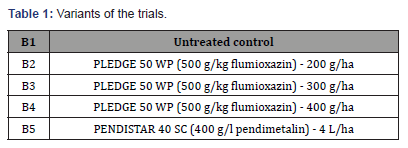
In the beginning of February, when the crop was in full rest was performed treatment with tested herbicides and dosages. The stage of the crop during application of the herbicides was BBCH 00. The used spray volume was 400 L/ha.
Results and Discussions
The experimental field was infested with the following important weeds for the lavender crop: Amaranthus retroflexus L.- 9,5 weeds per sq.m, Sinapis arvensis L., Chenopodium album L., Datura stramonium L., Poligonum Lapathifolium L., Hibiscus trionum L., Matricaria chamomila L., Solanum nigrum L., Abuthilon theoprasti L., Poligonum aviculare L., Portulaca Oleraceae L., Coniza canadensis L. and Cynodon dactylon (L.) Pers. All tested herbicides showed higher efficacy at 60 days after treatment compared to untreated control.
The herbicide PLEDGE 50 WP applied at the highest dose of 400 g/ha show almost 95-100% efficacy to all reported weeds except Cinodon dactilon.
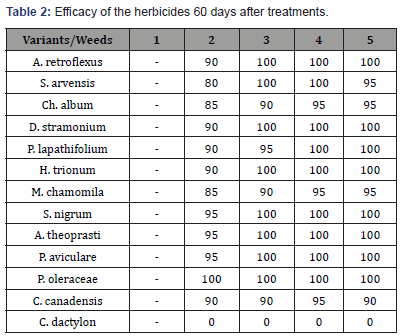
During the second assessment 90 days after the application of the herbicides the efficacy in all variants has been decreased.
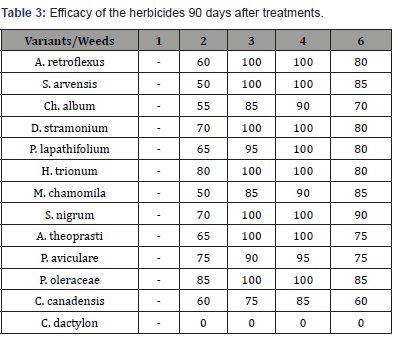
At 120 days after application of the herbicides the efficacy has been reduced.

The herbicides used in the experiments did not show any phytotoxicity to any of the varieties. Excellent efficacy was shown only from the herbicide PLEDGE 50 WP (Flumioxazin- 500 g/kg), applied in its highest dose of 400 g/ha. Only at this dose rate the herbicide retains its efficacy until one hundred and twentieth days after treatment. Only against the weed Coniza canadensis L its efficacy decreased to 60%. Compared to the untreated control, the lowest results are shown from the herbicide Pendistar 400 SC (pendimethalin 400 g/l) applied at the dose rate 4 L/ha.
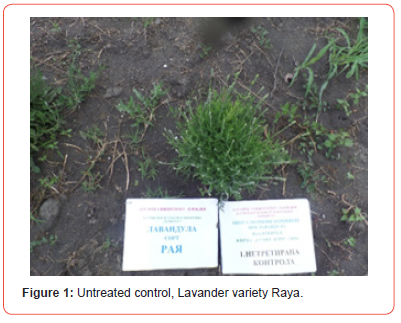
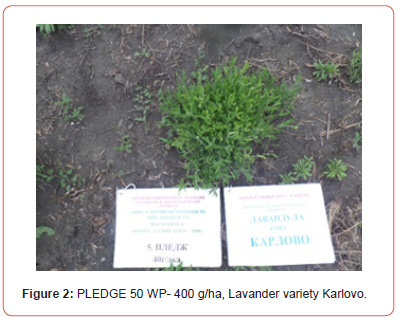
Conclusion
In the untreated control, 60 days after the application of herbicides, a strong secondary weed infestation has been reported.
On the 120th day after application the herbicide Pendistar SC had unsatisfactory efficacy against the existing weeds on the experimental field.
The rates of 200 and 400 g/ha of the herbicide product Pledge 50 WP had significant efficacy differences. The highest efficacy was found to be after the application at the rate of 400 g/ha.
The herbicide efficacy against the rhizome weed C. dactylon was zero for both herbicide products. The application of Pledge 50 WP (also in the high rates) and Pendistar 40 SC did not show visual phytotoxicity symptoms to any of the grown lavender varieties in the trial.
Acknowledgment
This research work was carried out with the support of the Department of Herbology from the Agricultural University- Plovdiv and the full support of Professor Tony Tonev, PhD.
Conflict of Interest
The authors declare no conflict of interest.
References
- Tonev T, Dimitrova M, Kalinova S, Jalnov I, Zhelyazkov I, et al. (2019) Herbology. Plovdiv.
- Beatovic D, Jelacic S, Kisgeci J, Moravcevic D, Krstic M, et al. (2012) Application of local peat in the lavender, Lavandula angustifolia Mill. Nursery production, Proceedings of 7th Cmapseec, Republic of Serbia.
- Georgieva A (2013) Grija za nasajdeniata, Sofia. Lavandula 52-56.
- Angelova D, Dobreva A (2011) Exploring the influence of some herbicides on the quality of essential oils of Lavander. Science and Technology 1(6): 77-79.
- Zhelyazkov I, Delibaltova V, Krastev T (2018) Study on the efficacy of some herbicides for weed control in lavender field. Research Journal of Agricultural Science 50(1): 178-185.
- Mathe A (2015) Medicinal and Aromatic plants of the world, Scientific, Production, Commercial and Utilization Aspects.
- Yanchev I (2017) Productivity and Quality of Bulgarian Lavander Variaties. Agronomy: 440-442.
- Velinova E, Tityanov M, Rankova Z, Moskova C, Dimova M, et al. (2018) Innovative products of plant protections and fertilizers Part 1: 15-16.
- Dima M, Croitoru M, Draghici R, Constantinescu E, Niculescu M (1999) Researches regarding on the efficacy and selectivity of herbicides to combat weeds from lavender on sandy soils. Annals of the University of Craiova - Agriculture, Montanology, Cadastre Series 46(1): 115-118.
-
Miroslav Tityanov*, Anyo Mitkov, Mariyan Yanev, Nesho Neshev, Tonyo Tonev, Zarya Rankova, Cveta Moskova and Evgenia Velinova. Efficacy and Selectivity of Herbicides Flumioxazin (Pledge 50 WP) and Pendimethalin (Pendistar 40 SK) in Lavender. Sci J Biol & Life Sci. 2(4): 2022. SJBLS.MS.ID.000544. DOI: 10.33552/SJBLS.2022.02.000544
-
Efficacy; Lavender; Selectivity; Phytotoxicity; Herbicides; Traditional crops; Farming systems; Essential oil crops; Weeds; Agricultural crops; Agrotechnical measures; Weed species; Mechanical hoeing; Healthy mature
-

This work is licensed under a Creative Commons Attribution-NonCommercial 4.0 International License.






